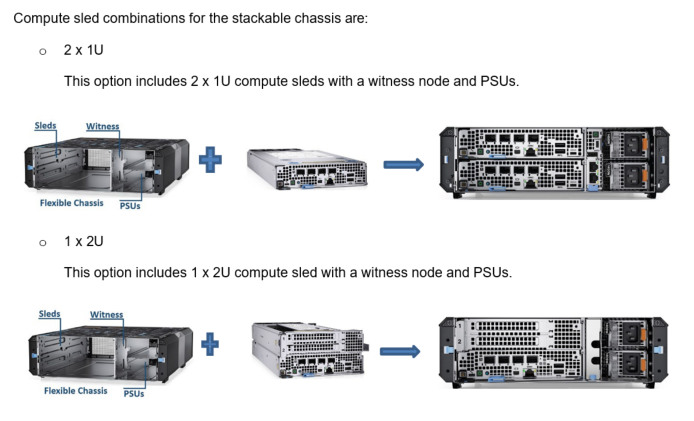

Dell PowerEdge XR4000: Multi-Node Design
Download PDFMon, 16 Jan 2023 19:31:49 -0000
|Read Time: 0 minutes
Summary
The Dell XR4000 is a compact multi-node server designed for the edge. This document discusses the XR4000’s unique form factors and sled options.
What is a multi-node server?
The Dell PowerEdge XR4000 is a rugged multi-node edge server with Intel’s next- generation Xeon D processor, making it a perfect fit for edge deployments. Available in two unique and flexible form factors, the “rackable” chassis supports up to four 1U sleds, and the “stackable” chassis supports up to two. Customers who need additional storage or PCIe expansion can choose a 2U sled option.
In addition, the XR4000 supports an optional witness node for single-chassis VMware vSAN cluster deployments. Each sled includes iDRAC for management, a CPU, memory, storage, networking, PCIe expansion (2U sled), and cooling.
Compute sleds
The compute sleds offer common features such as power and management connectors to the chassis backplane, pull handles and mechanical locks (for example, spring clips) for attachment to the chassis, side rails to aid insertion and stability in the chassis, and ventilation holes and baffles as appropriate for cooling.
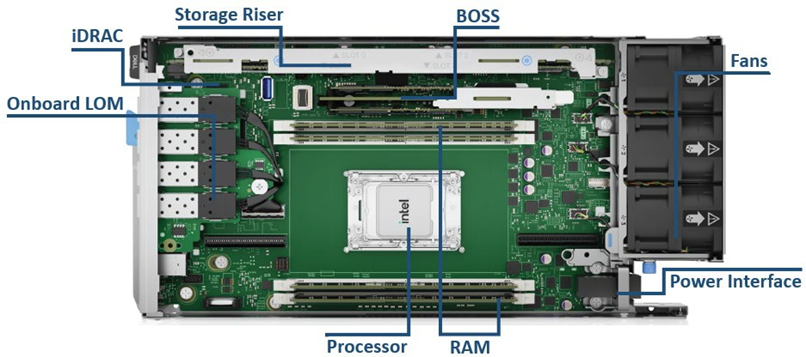
Figure 1. 1U compute sled interior
The XR4000 offers 1U and 2U sleds. The 1U sled is provided for dense compute requirements. The 2U chassis shares the same “1st U” and common motherboard with the 1U sled but includes an additional riser to provide two more PCIe Gen4 FHFL I/O slots.
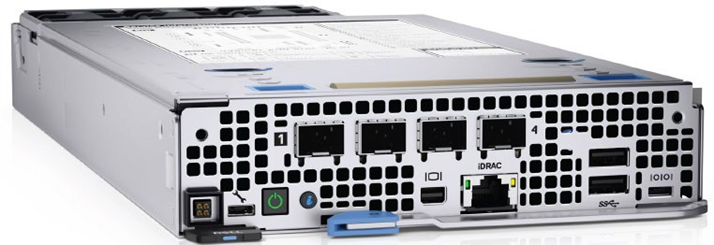
Figure 2. 1U compute sled
The 1U sled meets dense compute requirements, with storage up to 4 x M.2 drives (from 480 GB up to 3.84 TB each) and up to 2 x M.2 NVMe BOSS N1 ET. The memory can scale up to 512 GB total with 4 x memory slots. It also includes a LAN on motherboard (LOM) option with 4 x SFP from CPU.
2U compute sled
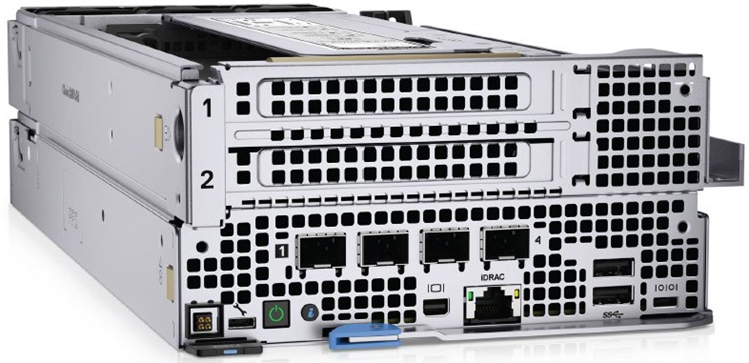
Figure 3. 2U compute sled interior
The 2U compute sled builds upon the common first 1U of the 1U sled with additional 2 x 16 FHFL PCIe 4.0 lots, with a combined power capacity of 250 W. These slots can support GPUs, such Nvidia A2/A30s, SFP, DPUs, SoC accelerators, and other NIC options. The additional storage option supports optional 8 x M.2 storage drives (4 x per x16 slot) and 12 x
M.2 total (not including BOSS).
Nano Server node
Each chassis also supports an optional low-power server called the Dell Nano Processing Unit or NPU. The NPU is an x86 sled built with Intel's Atom Processor C Series. Designed for the edge, the NPU includes industrial-grade components capable of reliable operation in an extended temperature range. For more information, see Dell PowerEdge XR4000: Nano Processing Unit.
Chassis with sleds
The two chassis types share the components of common 100 to 240 VAC power supplies (PSUs), up to two per chassis, and an optional embedded controller card called the Nano Server.
Both chassis types optionally include a lockable bezel to prevent unwanted access to the Sleds and PSUs, with intelligent filter monitoring that creates a system alert when the filter needs to be changed.
XR4000 is offered in two options for chassis:
- 2U rackmount chassis
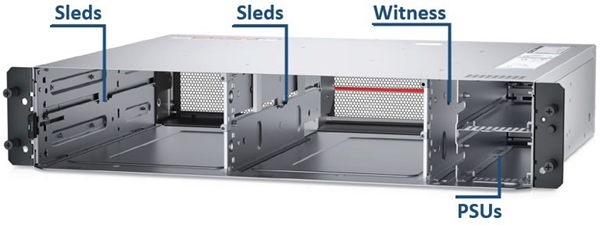
Figure 4. 2U rackmount chassis
The “rackable” chassis is a 2U, 14-inch (355 mm) deep, 19-inch-wide chassis, with mounting ears to support a standard 19-inch-wide rack. The rackable chassis supports both front-to-back and back-to-front airflow and the following combination of 1U and 2U compute sleds:
- 2U flexible/stackable mount chassis
The “stackable” chassis is also 2U, 14 inches (355 mm) deep, but is only 10.5 inches wide and is typically deployed in desktop, VESA plates, DIN rails, or stacked environments. The stackable chassis also supports both front-to-back and back-to-front airflow.
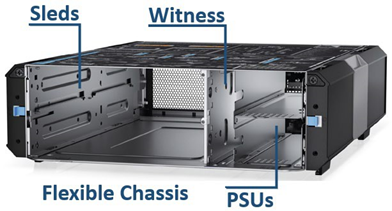
Figure 5. 2U stackable chassis
Service and manage
The XR4000 offers a front servicing (cold aisle) chassis option, which allows it to be deployed with all cables connected to the front. This option simplifies cable management and allows the server to be installed in areas where space is limited and access to the front and back of the chassis is not possible. Also, the sleds are designed to be easily field replaceable by non-IT personal.
Redundancy
The XR4000 multi-node server gives IT administrators the ability to deploy compact, redundant server solutions. For example, two sleds can be configured identically and installed in the same chassis. One acts as the primary, and the other is the secondary, or backup. If the primary server goes down, the secondary server steps in to minimize or eliminate downtime. This redundant server configuration is also a great way for administrators to seamlessly manage software updates. For example, administrators can deploy the secondary server while performing maintenance, updates, or development work on the primary server.
Scaling
The XR4000 server, with its unique form factor and multiple deployment options, provides flexibility to start with a single node and scale up to four independent nodes as needed. Depending on the requirements of various workloads, deployment options can change; for example, a user can add a 2U GPU-capable sled. The same sleds can work in either the flexible or rackmount chassis based on space constraints or user requirements.
Conclusion
PowerEdge XR4000 offers a streamlined approach for various edge deployment options based on different edge use cases. Addressing the need for a small form factor at the edge with industry-standard rugged certifications (NEBS and MIL-STD), the XR4000 ultimately provides a compact solution for improved edge performance, low power, reduced redundancy, and improved TCO.
References
Related Documents

Dell PowerEdge XR4000: Nano Processing Unit
Mon, 16 Jan 2023 19:39:35 -0000
|Read Time: 0 minutes
Summary
The Nano Processing Unit is an optional sled supported by the Dell XR4000 multi-node server. While its design aligns perfectly with the technical requirements of a VMware vSAN witness host, it can be used for many interesting edge use cases.
What is a Nano Processing Unit?
Dell Technologies is committed to delivering best-in-class edge servers. The latest member of the Dell PowerEdge XR edge server series is the PowerEdge XR4000 featuring the next-generation Intel Xeon D processor. This short-depth multi-node server is available in two different chassis form factors: rackable and flexible. The rackable chassis supports up to four Xeon D sleds, and the flexible supports up to two. Additionally, each chassis supports an optional low-power server called the Dell Nano Processing Unit, or NPU, discussed here.
The NPU is an x86 sled built with the Intel Atom Processor C Series. Designed for the edge, the NPU includes industrial-grade components capable of reliable operation in an extended temperature range. It is installed adjacent to the Intel Xeon D sleds in the PowerEdge XR4000 chassis and includes independent memory, networking, and storage. Besides providing power, the NPU is a self-contained server delivering up to a total of five independent sleds in the rackable chassis or three in the flexible chassis.

Figure 1. The XR4000 is multi-node. Each sled includes CPU, memory, storage, networking, and fans.
From the factory, Dell offers SUSE Linux Enterprise Server (SLES) or VMware ESXi on the NPU. We validated both operating systems, giving our customers the flexibility to use this unique server as a VMware vSAN witness host or put it to work in other exciting edge workloads, which we will discuss later. In addition, each NPU includes a unique Dell Service Tag and a customer-programmable field asset tag for customized asset tracking. The NPU does not feature Dell iDRAC.
The following table provides technical specifications of the NPU:
Feature | Technical specifications |
Processor | Intel Atom C3508 |
Memory | 16 GB ECC DDR4 1866 |
Storage | 1 x 960 GB M.2 NVMe |
Embedded management | N/A |
Embedded NIC | Intel i210 (2 ports) |
Ports | 1 x USB 3.0/2.0, 1 x Serial (micro-USB), 2 x 1 GbE RJ45, headless |
Operating systems | ESXi, Linux |
Operating temperature | 0–55°C |
NPU use case examples
The XR4000's unique NPU can serve a wide range of edge-computing use cases. Here are a few examples.
vSAN witness host
A two-node vSAN or vSAN stretched cluster configuration requires a witness host to act as a tie-breaker when a fault occurs. In a two-node vSAN, a fault could be a single node's power loss or hardware failure. In a stretched cluster, it might be the loss of an entire site due to a natural disaster. In either case, the witness host determines which node contains the valid data after the fault is resolved and nodes return to the cluster. The XR4000 NPU meets the requirements of a hardware vSAN witness host. It is installed in the same chassis as the compute nodes, enabling a compact vSAN cluster that can be deployed almost anywhere.
Emergency power server
Equipment deployed in a telephone network's central office, a manufacturing facility, or in a retail backroom might be more exposed to the effects of natural disasters or extreme temperatures. For example, a remote site might experience an extended power outage due to a natural disaster. During this
time, a site battery backup can keep some of the infrastructure running for a short period; however, high-power equipment can quickly consume the battery or fuel capacity. The low-power NPU can help preserve precious battery power until power returns when used as a site manager to monitor environmental sensors and security access, view camera feeds, and gracefully shut down high-power equipment to preserve power. Once site power returns, the NPU can remotely restore the site to full functionality by gracefully managing the power-on of connected site equipment, negating the need to send out a technician.
Private network security
Isolating a private network from the Internet increases security and reduces the number of potential attack vectors. Isolated networks improve network security but present challenges for IT administrators who access and manage them remotely. One solution is to use a "jump box" or "bastion host" that acts as a secure bridge between the Internet and a private network. This single, secure bridge can be hardened, monitored, and regularly audited to ensure only authorized users access the private network. IT administrators can configure the NPU as a secure bridge between the Internet and a private network.
Telemetry management host
Monitoring the health and performance metrics of servers, systems, and services operating at edge locations is critical. IT administrators use monitoring systems such as Prometheus to monitor, detect, and alert when collected metrics indicate potential issues in their fleet. They also use tools such as Grafana to visualize the data in easy-to-consume charts and graphs. The NPU's hardware specifications meet the hardware requirements of monitoring systems such as Grafana and Prometheus, and the NPU can serve as an out-of-band server running these tools.
Out-of-band management
Managing a fleet of servers and IT equipment is challenging. Administrators must manage the health and performance of equipment deployed across multiple sites or at remote locations. So, it might not always be cost-effective or feasible to send out a technician to resolve an issue, update or provision equipment, or check the status of a site. In these cases, having an out-of-band server like the NPU gives administrators the ability to remotely troubleshoot, deploy firmware updates, and manage devices such as intelligent PDUs and USB devices. When troubleshooting, administrators can use the out-of-band NPU server to power-cycle faulty devices connected to intelligent PDUs and collect debug logs from other devices; when provisioning, they can use it as a PXE server. Additionally, administrators can automate troubleshooting and provisioning functions, and the NPU can run those scripts.
Conclusion
The Nano Processing Unit is a unique and versatile computing server. Its edge-optimized design has industrial-grade components, a low-power processor, and more-than-capable memory, networking, and storage capacity. These features make it an excellent addition for customers looking to get the most out of their XR4000 server.
References
VMware Virtual Blocks Blog: Shared Witness for 2-Node vSAN Deployments

Optimizing Performance Per Watt with Dell PowerEdge XR Servers
Thu, 14 Mar 2024 16:48:00 -0000
|Read Time: 0 minutes

Executive Summary
With power and cooling costs accounting for increasingly large portions of IT budgets, IT departments looking to minimize total cost of ownership (TCO) are making power efficiency a priority when choosing server hardware. This white paper will examine the power efficiency of Dell Edge servers in the multi-node, 2U form factor, a form factor that is one of the most popular in many Edge and Telecom use cases because of the balance it strikes between density and expandability. This white paper will present and analyze power efficiency results for several Dell current-generation PowerEdge XR servers and also illustrate how those results compare on various parameters with a prior-generation Dell Edge server.
The environmental conditions for telecom edge computing are typically vastly different than those at centralized data centers. Telecom edge computing sites might, at best, consist of little more than a telecommunications closet with minimal or no HVAC. Thus, ruggedized, front-access servers are ideal for such deployments. The Dell PowerEdge servers checks all of the boxes.
Dell Technologies commissioned Tolly to evaluate the power efficiency of Dell’s XR8000, XR4000, XR5610, and XR11 servers using the industry standard Standard Performance Evaluation Corporation (SPEC) SPECPower benchmark and compare those to each other. The SPECPower benchmark measures server-side Java (SSJ) throughput and system power consumption. The benchmark calculates SSJ operations per watt of system power consumed. All analysis was based on public data submitted to the SPEC and published on their website.[1]
The Dell PowerEdge XR8000, XR4000, XR5610, and XR11 are all highly-capable edge servers but offer customers different options with respect to form factor, CPU specifications, and power efficiency/cost. The following summary tables provide insights into the value each offers from a different perspective of performance, cost, and energy usage.
The first table, below, summarizes the raw performance results calculated by SPECPower. As one would expect, the newer systems deliver higher performance per watt the older systems. The XR5610[2] and XR11 were measured on 32 cores where the other two systems were measured on 64 cores.
Table 1. SPECPower - Performance/Watt
 The second table, below, analyzes results on a “per core” basis as the various Dell systems have either 32 or 64 cores. The XR4000 results are 26% higher than the XR11 results, the XR8000 results are 42% higher than the XR11, and the XR5610 results are 62% higher than the XR11 roughly tracking the results shown in the previous table for the entire systems.
The second table, below, analyzes results on a “per core” basis as the various Dell systems have either 32 or 64 cores. The XR4000 results are 26% higher than the XR11 results, the XR8000 results are 42% higher than the XR11, and the XR5610 results are 62% higher than the XR11 roughly tracking the results shown in the previous table for the entire systems.
Table 2. SPECPower - Performance/CPU Core
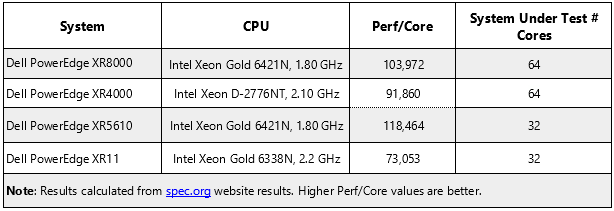
The third table, below, calculates watts consumed per CPU core without reference to performance.The XR4000 and the XR11 results are within 2% of each other. The XR8000 results are13% better than the XR11 and the XR5610 results are 7% better than the XR11. Note that the XR11 is powered by an Intel 3rd Gen Xeon SP CPU while the XR4000 is powered by an Intel Xeon-D CPU.
Table 3. SPECPower - Watts/CPU Core

The fourth table, below, factored in the cost of the CPU into the perf/watt equation. Thus, lower cost CPUs will have higher values in this table when the raw performance is the same as higher cost CPUs. The XR4000 results are 120% better than the XR11 results, the XR8000 results are 110% better than the XR11, and the XR5610 results are 104% better than the XR11.
Table 4. SPECPower - Perf/Watts/CPU Cost

The fifth table, below, provides links to details of each of the CPUs evaluated.
Table 5. Dell PowerEdge Server Systems - Intel CPU Detail Links
System | CPU | Intel Reference Link |
Dell PowerEdge XR8000 (XR8620T) & Dell PowerEdge 5610 | Intel Xeon Gold 6421N, 1.80 GHz | |
Dell PowerEdge XR4000 | Intel Xeon D-2776NT, 2.10 GHz | |
Dell PowerEdge XR11 | Intel Xeon Gold 6338N, 2.2 GHz |
Competitive Positioning
Based on the publicly available data from spec.org/power, we can see high capacity data intensive workload targeted HPE and Supermicro servers. Although these are not direct competitors to Dell PowerEdge XR servers, it is worthwhile to note that the perf/watt/CPU$ for XR8000 is better than both HPE ProLiant DL360 Gen11 (Intel Xeon Platinum 8480+ 2.0 GHz), HPE ProLiant DL380 Gen 1 (Intel Xeon Platinum 8480+ 2.0 GHz), as well as the Supermicro SYS-621C-TN12R (Intel Xeon Platinum 8490H 1.90GHz).
Dell XR servers provide solutions for various edge workloads in a short form factor, edge optimized with power efficiency consideration taken into account.
Air Cooling
Dell created Multi-Vector Cooling (MVC) to maximize the potential of air cooling. It includes control algorithms, thermal and power sensors, component mapped fan zoning and airflow channeling shrouds to balance and intelligently direct airflow across the systems’ components.
New high-performance fans and heatsinks, as well as special airflow-optimized configurations, ensure even high-power CPUs are supported without throttling.
For more information, go to https://www.dell.com/en-us/blog/better-ways-to-cool-your-poweredge-servers, read this “Direct from Development” (DfD) note https://infohub.delltechnologies.com/p/understanding-thermal-design-and-capabilities-for-the-poweredge-xr8000-server, or view a video on the topic at: https://www.youtube.com/watch?v=-rHEXJsX75Y&ab_channel=DellTechnologies.
Telecom Edge Computing
Wireless telecom providers world-wide have at least two things in common: seemingly endless growth, and the rapid migration from specialized, proprietary radio access network (RAN) hardware to scalable, software-based vRAN solutions. Over two dozen system operators and nearly 300 related companies and academic institutions are part of the Open RAN Alliance (O-RAN) working together to bring an open solution to the industry.[3]
The telecom edge, thus, needs ruggedized servers built to resist demanding environmental conditions while delivering significant compute power with cost-efficient use of electric power.
Dell, an acknowledged information technology leader, builds servers that are designed for both the processing requirements and physical deployment requirements of edge servers with a particular focus on telecom applications. In particular, the Dell PowerEdge XR8000 and Dell PowerEdge XR4000 edge servers provides a powerful and flexible selection of configurations focused on the particular needs of the telecom edge.[4]
- Built to withstand extreme heat & dust; operating temperature range from -5 to 55C
- Efficient use of electric power
- Suitable for shock and vibration of factory floors & construction site
- Can be deployed in distributed telecom and other extreme environments
- Short depth (355mm), small form factor
- Ruggedized; tested for NEBS and MIL-STD
- Multi-node capable
PowerEdge XR4000: Scalability and Flexibility with HCI Capabilities
The Dell PowerEdge XR4000 Edge Server is part of Dell’s family of purpose-built, ruggedized servers. The PowerEdge XR4000 is built for environments like telecom edge deployment or factory floors where the servers could be subjected to demanding conditions including high temperatures, dust, shock and vibrations.
The high-performance, multinode XR4000 server was purpose built to address the demands of today’s retail, manufacturing and defense customers. It was designed around a unique chassis and compute sled(s) concept. The actual computer resides in modular 1U or 2U sled form factors. The only shared component between the sleds is power. The server is also designed to support hyperconverged infrastructure (HCI).
The XR4000 is available in two 14" depth “rackable” and “stackable” chassis form factors. The optional nano server sled replaces the need for a virtual witness node. The in-chassis witness node allows for native, two-node vSAN clusters in the stackable server chassis.
The servers are small form factor, short depth units that can be deployed alone or in multi-node configurations.

The XR4000 used for this test was an XR4520c 2U compute sled. See table below for key specifications.
Table 6. Dell PowerEdge XR4520 Compute Sled Key Specifications
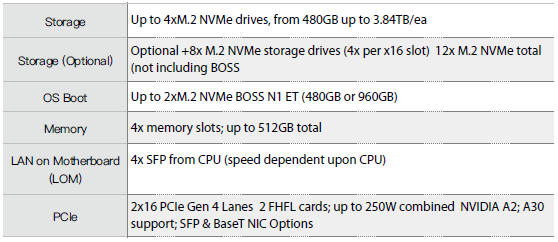
PowerEdge XR8000: Flexible, Innovative, Sled-based RAN-Optimized Server
The Dell PowerEdge XR8000 Edge Server is the newest addition Dell’s family of purpose-built, ruggedized servers. The PowerEdge XR4000 is built for environments like telecom edge environments where the servers could be subjected to demanding conditions including high temperatures, dust, shock and vibrations.
The short-depth XR8000 server, which comes in a sledded server architecture (with 1U and 2U single-socket form factors), is optimized for total cost of ownership (TCO) and performance in O-RAN (radio access network) applications. It is RAN optimized with integrated networking and 1/0 PTP/SyncE support. And its front-accessible design radically simplifies sled serviceability in the field.
The XR8000 offers options for multiple sled form factors with up to four nodes per chassis that can work together or independently. The 2U half-width sled configuration accommodates general purpose compute at the edge / far edge, while the 1U half-width sled configuration is ideal for dense compute and network edge-optimized workloads.

Table 7. Dell PowerEdge XR8620 Compute Sled Key Specifications
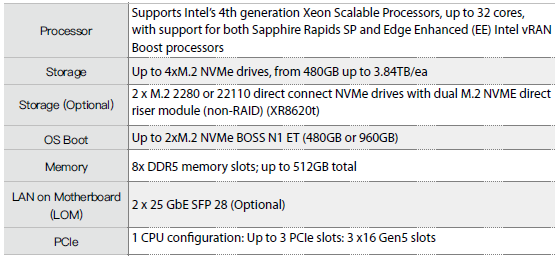 The XR8000 delivers extended tolerance to heat and cold with enhanced heatsinks and optimized airflow design. The system supports Sapphire Rapids SP and Edge Enhanced (EE) processors with Intel vRAN Boost, on-chip acceleration and includes both DC and AC power supply options and five total power supply unit (PSU) variants
The XR8000 delivers extended tolerance to heat and cold with enhanced heatsinks and optimized airflow design. The system supports Sapphire Rapids SP and Edge Enhanced (EE) processors with Intel vRAN Boost, on-chip acceleration and includes both DC and AC power supply options and five total power supply unit (PSU) variants
PowerEdge XR5610: All-Purpose, Rugged 1U Edge Server
The Dell PowerEdge XR8000 Edge Server is a new addition Dell’s family of purpose-built, ruggedized servers. As with the PowerEdge XR8000 and PowerEdge XR4000, the PowerEdge XR5610 is built for environments where the servers could be subjected to demanding conditions including high temperatures, dust, shock and vibrations. The XR5610 is the upgraded successor to the XR11 that is also covered in this report.
The PowerEdge XR5610 is a 1U, single-socket server designed for target workloads in networking and communication, enterprise edge, military, and defense. It is well suited for 5G vRAN and ORAN telecom workloads, as well as military and defense deployments and retail AI including video monitoring, IoT device aggregation and PoS analytics. The design specification supports continuous operation in extreme temperatures ranging from -5C to 55C. The design is ruggedized, compliant, and compact.
The server features a filtered smart bezel for dust reduction and the server has undergone MIL810H and NEBS Level 3 testing for handling shocks and vibrations.

Table 8. Dell PowerEdge XR5610 Key Specifications
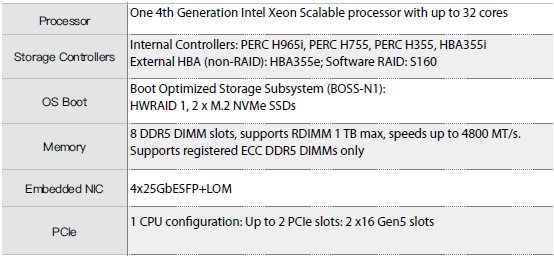
SPECPower Workload & Results
The Standard Performance Evaluation Corporation (SPEC), according to their website, “is a non-profit corporation formed to establish, maintain and endorse standardized benchmarks and tools to evaluate performance and energy efficiency for the newest generation of computing systems. SPEC develops benchmark suites and also reviews and publishes submitted results from our member organizations and other benchmark licensees.”
SPEC has established benchmarks, to date, in some nine different areas. In addition to power, the focus of this report, the benchmarks include Machine Learning, High Performance Computing, Virtualization, and more.
Server vendors run the benchmark tests in their own labs according to the SPEC benchmark specifications. Vendors may use the results internally and/or they can submit the results to SPEC for review and publication. Once published, the results are freely available and can be used by others in public reports so long as that use complies with the SPEC “Fair Use Policy” for the given benchmark.
SPECPower_ssj2008 Benchmark
As evidenced by its name, the SPECPower benchmark was issued in 2008. The workload, represented in the name by “ssj,” is “Server Side Java (SSJ).“ The benchmark drives the load on the target server while also measuring the power consumption of the server.
While the benchmark allows for different java virtual machines (JVM) to be used in the benchmark, the Oracle JVM is used almost exclusively for the tests. The results document CPU and memory configurations of the systems and reports “submeasurements” of SSL operations at 100% CPU, average watts consumed at 100%, and average watts at idle. The result reported is the overall SSJ operations divided by the watts consumed.
It is important to note that the test is run at 10 different loads from 10% to 100% in increments of 10% load. Only the 100% results are displayed in the SPECPower results table but the SPECPower “result” value is an average of all ten tests.
Raw Results
All results referenced in this report are available to the general public on the SPEC site at: https://www.spec.org/power_ssj2008/results. The information in the following tables is excerpted from the public results. The table, below, contains the submeasurements and the final result for each system discussed in the paper. All other results in this paper are calculated using the the SPECPower raw results below.
Table 9. SPEC SPECPower_ssj2008 Results

Server Specifications
The table, below, contains the server system specifications as shown on the SPEC results website. All systems were tested using Oracle Corporation’s JVM.
Table 10. Server System Specifications
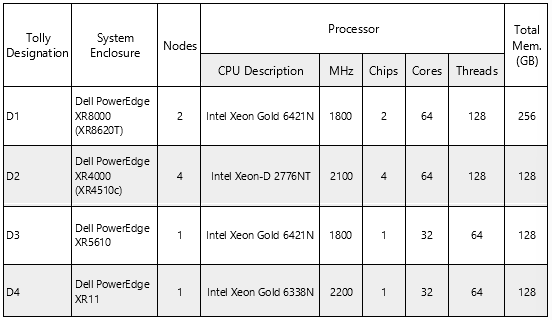
System BIOS Settings
The tests used Dells recommended BIOS settings for power efficiency. The Dell PowerEdge XR8000 and Dell PowerEdge XR4000 systems both used the following BIOS settings.
Table 11. Server System BIOS Settings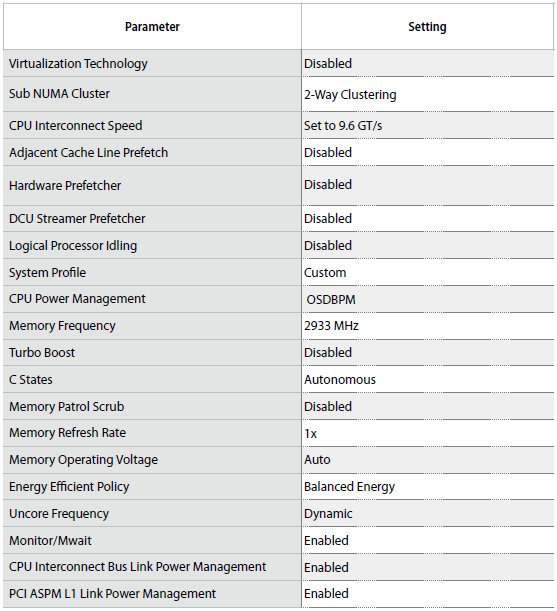
XR Series Price/Power Efficiency Claims
The charts below visualize the tabular results presented in the Executive Summary section earlier in this report.
Performance/Watt (Performance-to-Power-Ratio)
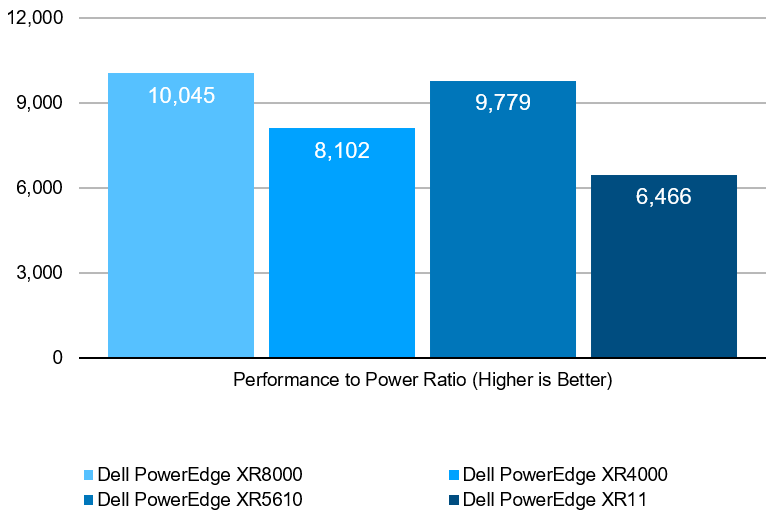
Performance/CPU Core
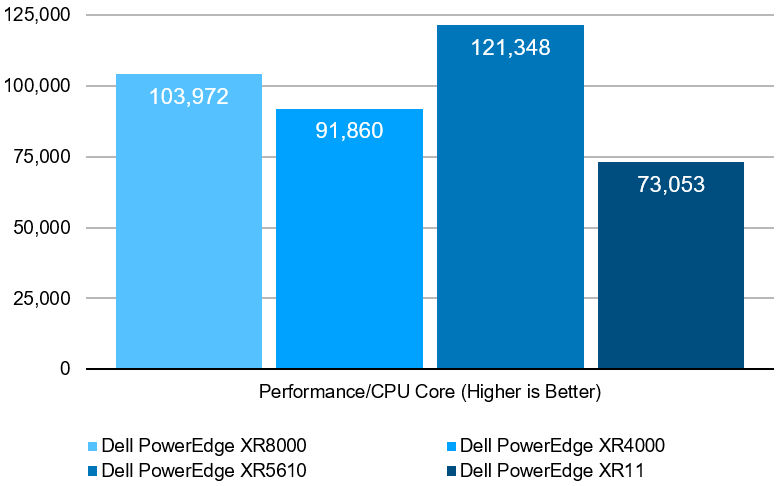
Watt/CPU Core
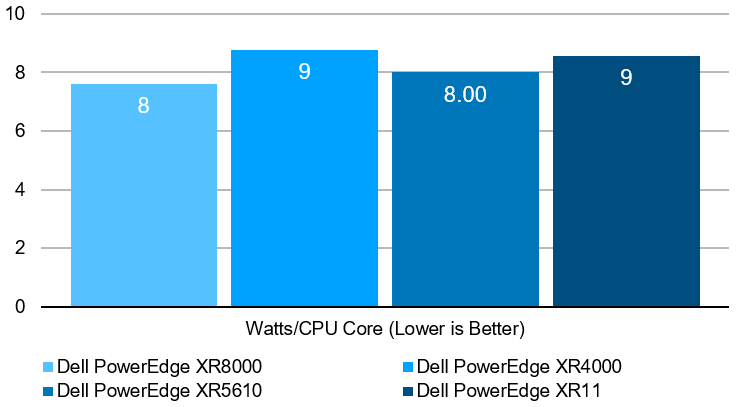
Performance/Watt/CPU Cost
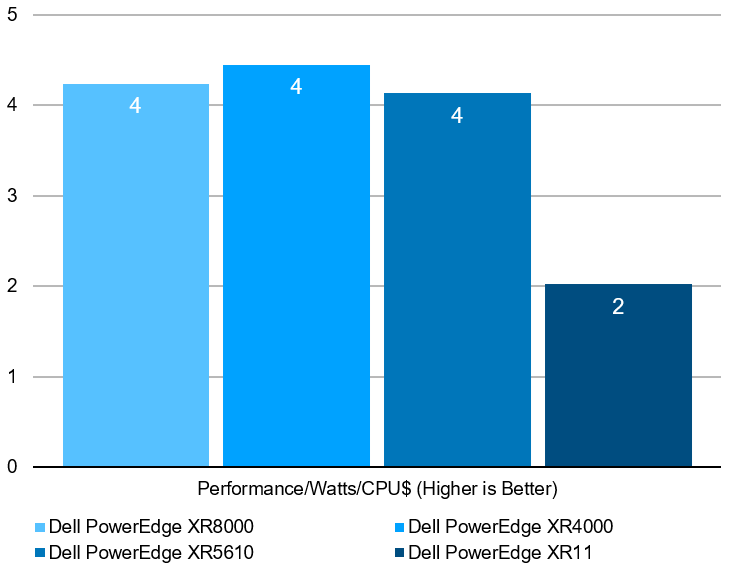
About Tolly
The Tolly Group companies have been delivering world-class IT services for more than 30 years. Tolly is a leading global provider of third-party validation services for vendors of IT products, components and services.
You can reach the company by E-mail at sales@tolly.com, or by telephone at +1 561.391.5610.
Visit Tolly on the Internet at: http://www.tolly.com
Terms of Usage
This document is provided, free-of-charge, to help you understand whether a given product, technology or service merits additional investigation for your particular needs. Any decision to purchase a product must be based on your own assessment of suitability based on your needs. The document should never be used as a substitute for advice from a qualified IT or business professional. This evaluation was focused on illustrating specific features and/or performance of the product(s) and was conducted under controlled, laboratory conditions. Certain tests may have been tailored to reflect performance under ideal conditions; performance may vary under real-world conditions. Users should run tests based on their own real-world scenarios to validate performance for their own networks.
Reasonable efforts were made to ensure the accuracy of the data contained herein but errors and/or oversights can occur. The test/audit documented herein may also rely on various test tools the accuracy of which is beyond our control. Furthermore, the document relies on certain representations by the sponsor that are beyond our control to verify. Among these is that the software/hardware tested is production or production track and is, or will be, available in equivalent or better form to commercial customers. Accordingly, this document is provided "as is", and Tolly Enterprises, LLC (Tolly) gives no warranty, representation or undertaking, whether express or implied, and accepts no legal responsibility, whether direct or indirect, for the accuracy, completeness, usefulness or suitability of any information contained herein. By reviewing this document, you agree that your use of any information contained herein is at your own risk, and you accept all risks and responsibility for losses, damages, costs and other consequences resulting directly or indirectly from any information or material available on it. Tolly is not responsible for, and you agree to hold Tolly and its related affiliates harmless from any loss, harm, injury or damage resulting from or arising out of your use of or reliance on any of the information provided herein.
Tolly makes no claim as to whether any product or company described herein is suitable for investment. You should obtain your own independent professional advice, whether legal, accounting or otherwise, before proceeding with any investment or project related to any information, products or companies described herein. When foreign translations exist, the English document is considered authoritative. To assure accuracy, only use documents downloaded directly from Tolly.com. No part of any document may be reproduced, in whole or in part, without the specific written permission of Tolly. All trademarks used in the document are owned by their respective owners. You agree not to use any trademark in or as the whole or part of your own trademarks in connection with any activities, products or services which are not ours, or in a manner which may be confusing, misleading or deceptive or in a manner that disparages us or our information, projects or developments.
Tolly Report #223124
August 2023
© 2023 TOLLY ENTERPRISES, LLC www.tolly.com
[2] At publication time the XR5610 results were being prepared for submission to SPEC and should appear later in Q3 2023.




